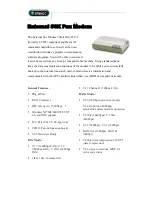
Qlink-3000 Multiplexing modem
1234567890123456789012345678901212345678901234567890123456789012123456789012345678901234567890121234567890123456789012345678901212345678901234567
1234567890123456789012345678901212345678901234567890123456789012123456789012345678901234567890121234567890123456789012345678901212345678901234567
Copyright © 2003 -2005 Cronyx Engineering
29
The upper line contains device model name, revision code and firmware date.
Then configuration parameters and modes for the SHDSL port (Link) and data ports
(Port 0 and Port 1) are displayed.
The following parameters are displayed for the SHDSL port (Link):
• Mode: CO (Central Office) or RT (Remote terminal);
• Link transmission data rate (this parameter is not displayed if connection is not
established);
• Signal/noise ratio on the local and the remote (in parentheses) devices (these
parameters are not displayed if connection is not established);
• PCLK source;
• Link testing mode: Loop - loop is enabled on the link, Remote loop- remote loop
request enabled, Test - BER tester enabled. When the BER tester is enabled, the
measurement results are displayed:
• Current Test error rate;
• Time passed;
• Total errors detected during testing time;
The following parameters are displayed for the E1 port (Port 0, Port 1):
• Mode (E1, Unframed) and useful bandwidth (Nx64 kbps, n=1..32);
• Maximum receiver gain (Low Gain - 12 dB, High gain - 43 dB);
• 16-th timeslot mode (Use16 - timeslot 16 may be used for data, Skip16 - CAS signaling
is transmitted in the 16-th timeslot);
• CRC4 multiframe generation and check need indicator (CRC4, no CRC4);
• Idle code
• Testing mode: Loop - loop enabled on the port, Tloop - port tributary loop enabled -
port disabled, TTest - BER tester enabled on port tributary. When the BER tester is
enabled, the measurement results are displayed:
• Current Test error rate;
• Time passed;
• Total errors detected during testing time;
The following parameters are displayed for the Ethernet port (Port 1):
• Useful bandwidth (Nx64 kbps, n=1..36);
• Port mode (100Base-T or 10Base-T);
• Duplex type (Half Duplex or Full Duplex);
• Ethernet frame filtering disable indicator (No filtering);
If E1 port(s) operates in the framed mode, then the timeslots transmitted over the SHDSL
link are displayed for them.
















































